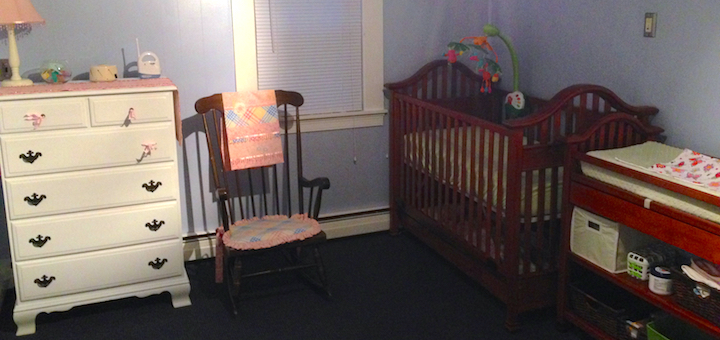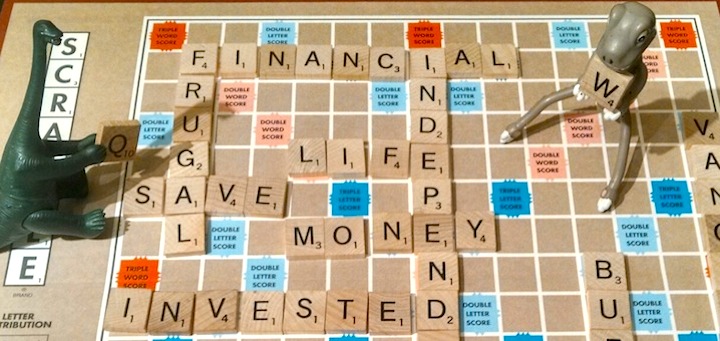
In the spirit of the holiday season, today I’m discussing how and why Mr. Frugalwoods and I make charitable donations. First, permit me to set the scene. Mr. FW and I consider ourselves to be very fortunate. And among our many, many blessings (which I enumerate here) is our wealth. Although we’re not rich by the standards of Wall Street or corporate CEOs, we’re well off. We’ve grown our wealth by saving exceedingly high percentages (circa 70-82%) of our income every year and investing these savings in low-fee index funds and a revenue-generating rental property.
Through our savings, we’ve enabled a move to our dream home on 66 acres in the woods of Vermont. Through our savings, I was able to quit my day job and instead pursue a career I adore–writing for you fine people–from home. Through our savings, we’re able to stay home and care for our daughter full-time (and Frugal Hound too, of course). Through our savings, we’ve built a nest egg we could live off of for the rest of our lives. But all of that is another story for another time.

What I want to talk about today is the desire–and I’d even say the requirement–that Mr. FW and I feel to give back. Sure, we’ve made some smart decisions about our money and sure, we’ve made some sacrifices, but our efforts pale in comparison to the hardships faced by those less fortunate than us. We don’t feel that we deserve all the credit for the money we have, and so, we share it. Additionally, we want to teach our daughter from a young age to give back, which I think is a lesson best learned by example. It’s an example both of our parents set, and their demonstrations of generosity resonate with us to this day.
Previously, I’ve discussed our privilege in depth as well as my philosophy of living out compassion in a world of judgement. One of the ways that we live out our compassion is through philanthropy. Mr. FW and I both give of our time through volunteer work in our local community, but there’s truly no substitute for donating cold hard cash. For that reason, we choose to give of both our time and our financial resources.
While giving away money might seem anathema to frugality, I actually think it’s a wonderful benefit of living a frugal life. If Mr. FW and I didn’t adhere to a lifestyle of extreme frugality, there’s a lot we wouldn’t be able to do–and charitable giving is one of those things. I think of it as a fulfilling aspect of life for those of us circumspect with our personal resources.
How We Give: A Donor Advised Fund
Let me first address the mechanics of our giving: Mr. FW and I have a Donor Advised Fund through Fidelity. A Donor Advised Fund (or DAF) is essentially a tax-advantaged way of making philanthropic gifts. Here’s how it works: you put the amount you want into your DAF and you receive a tax deduction for the full amount in that calendar year. Then, you make allocations from your DAF to nonprofits over the course of as many years as you choose. The money in your DAF may only be used for philanthropic contributions, but you get to choose the nonprofits you support. Another note with a DAF is that you can’t use the funds for a donation where goods or services are received. For example, you can’t make a grant from a DAF to cover your ticket to a nonprofit’s gala event.
There are several advantages to utilizing a Donor Advised Fund:

1) If you contribute to a DAF in a high tax year, you’ll reduce your taxable income for that year. This is due to the fact that you receive the deduction for your full contribution amount in the calendar year you put money into the DAF–not when you make allocations to charities from the DAF.
2) It’s a way of strategically mapping out your philanthropy, because you’re setting aside a chunk of money earmarked exclusively for charitable contributions. You can’t do anything else with that money, so you’re ensuring you’ll remember to be a philanthropist every year.
3) The money in a DAF is invested, which means it’ll grow tax-free over the years. Hooray! Hence, you can plan to contribute the spin-off from the DAF’s investments each year. This way, you can ensure you’ll be able to contribute to nonprofits you care about for decades to come. Our goal through our DAF is to sustain our philanthropy for the longterm.
4) You can contribute assets and/or cash to a DAF, which is another excellent tax advantage. Mr. FW and I contributed our most appreciated assets, which in our case, were index funds we’d purchased in 2009. Hence, they’d seen robust appreciation and had we sold them, we would’ve owed a great deal in taxes. By instead contributing them to our DAF, we were able to skip realizing those capital gains taxes and instead deducted the full market value of the securities from our taxes this calendar year. In short, you’re able to avoid paying taxes on appreciation through donating to a DAF and, you become a philanthropist in the process. It doesn’t get any better than that!

To further illustrate the awesome advantage I outline in #4, here’s a hypothetical scenario:
Fred and Franny Frugal donate $50K to a DAF in a year where their federal marginal rate is 28% and their state marginal rate is 8.8%. The $50K is comprised of longterm appreciated stock with a cost basis of $30K, which means it has $20K of longterm capital gains.
Here are the tax savings they’ll realize from this donation:
Savings of a $50K deduction: $18,400
+ Savings of not paying longterm capital gains tax: $3,000
= Total tax savings: $21,400
(please note: this is somewhat simplified and should not be taken as tax advice)
By donating $50K in one year, Fred and Franny are maximizing their tax benefits. This is doubly true if they predict they may have low marginal tax rates in the future.
We chose to open our DAF through Fidelity for several reasons (by the way, Fidelity isn’t paying me to tell you this, although I kind of wish they were… ):
- It costs nothing to open and there’s no minimum balance requirement.
- The minimum amount required to open a DAF is just $5,000.
- Fidelity’s annual administrative fee for managing DAFs is quite low: $100 or 0.6% of assets under management, whichever is greater.
- It’s basically the low-fee index fund of the charitable giving sphere, and in fact, you can choose to have your DAF invested in low-fee index funds!
- They have an easy-to-use online interface and, all of our other accounts are already through Fidelity, which made the whole process even easier.
- They are lovely and very helpful over the phone, should you have questions (which I did).
Where We Give: Strategic Philanthropy

I’m going to share a secret: I worked as a nonprofit fundraiser for ten years before deciding my true calling was writing about personal finance. I tell you this so that you understand the basis for my philosophy. I’ve been on both sides of a solicitation and so the perspective I share is somewhat unique (of course, not unique for all my fellow fundraisers reading this, of which I know there are many!).
Another aspect undergirding my philanthropy is the efficiency doctrine that Mr. FW and I live by. Ok, it’s not really a doctrine, it’s just that we like to approach all things with an analytical lens and an eye towards efficiency.
We Give To Small Institutions
These two factors form the basis for our primary decision as philanthropists: we give to small organizations.
As someone who has raised money for large and small institutions, I can tell you that your small dollar gift (by which I mean anything under a single gift of $25,000) will go significantly farther at a small organization. There are many incredible large nonprofits doing the literal work of God, but a $100 or even $1,000 check is simply a drop in the bucket for them. Their fundraising resources are far better spent on pursuing more substantial gifts–I’m talking the $1 million+ category. I wish I had that much money to give away annually, but alas, it ain’t so.

For the amount that I do have to contribute each year, I prefer giving to organizations with budgets under $500,000, which is a pretty darn low annual operating budget. I can be relatively assured that my level of support will make actionable change in a budget that small.
If you’re wondering how to assess a nonprofit’s budget, you can ask them for a copy of their annual report, which might also be available on their website. However if, like me, you support organizations too small to supply an annual report, you can simply check out their Form 990 through Charity Navigator, or by googling. All 501(c)(3)s (that’s the IRS tax identifier for a nonprofit organization), except for churches, are required to fill one out every year. Handy!
I love reading 990s (nerd alert) because they inform me not only of an organization’s overall budget, but also how they’re spending their money. Does their CEO have a gigantic salary? Or are they funneling most of their resources into serving their constituency? I think it’s incumbent upon donors to learn as much as they can about nonprofits before supporting them. I also don’t expect small nonprofits to aggressively steward or solicit me–that takes precious resources I’d rather they direct towards serving their mission. I’m happy to do my own research and determine my own giving timeline and priorities.
We Give Locally

Another tenet of our philanthropy is that we give hyper-locally. Our rationale for this is simply that we love our new community, we love our adopted home state, and we want to be a force for good to the extent that we’re able. For that reason, we’ve decided to support local organizations only.
We Give To Our Priorities
I think it’s important to support the things you’re most passionate about. Renowned philanthropists have transformed the landscape of fields such as health, education, and the arts simply by focusing their contributions. I see nothing wrong with supporting what matters most to you–and in fact, I think it makes for a more committed philanthropist.
To that end, since there are two people making the giving decisions here at Frugalwoods HQ, we decided to support several organizations we mutually agree on and then each choose an organization that’s of especial concern.
The Organizations We’ll Support in 2017

My choice: One of my passions is helping women in need–be it providing access to healthcare or fostering programs that empower women–that’s my thing. And so, I selected a local organization that provides resources for women who are victims of domestic violence.
His choice: Mr. FW selected a local nonprofit news organization that conducts investigative journalism into issues affecting Vermonters. As firm believers in the importance of unbiased journalism to strengthen our democracy, this is a local institution whose work we want to foster.
Our choice: Together, we decided to support our church and our town’s community center (which provides a free summer camp for kids, lunches for seniors, town dinners and festivals, scholarships for local kids, and more). We’re also deviating slightly from our otherwise hyper-local, hyper-small guidelines in order to be members of our state’s NPR station, Vermont Public Radio. We listen to VPR every single day and their news coverage is indispensable to us. I just have to support NPR!

Sidenote: I should also note that Mr. FW and I make small gifts throughout the year to such things as local chicken dinner fundraisers, friends’ causes/runs/events, the giving tree at church, etc. We don’t make these grants from our DAF since they’re typically cash or in-kind donations. We also don’t apply our rigorous vetting process of reviewing 990s and determining strategic amounts. We just buy the chicken dinner and don’t worry about it.
We Make A Few Larger Gifts
As you’ll note, we’re only making gifts to five organizations. It’s our belief that making several larger donations has a greater impact as it concentrates our resources. Plus, nonprofits incur costs surrounding each donation they receive. Staff are required to process a gift, write a tax acknowledgement letter, enter the donation into a database, allocate the donation, report it on their 990, steward the gift, and then re-solicit the donation next year.
Knowing the inner machinations of fundraising like I do, I prefer to limit the staff resources required to handle my contributions. Giving through a DAF is another way to lessen this burden on nonprofits: since the tax deduction for the gift has already been received by the donor (in the year the DAF was funded), nonprofits aren’t required to send acknowledgment letters for gifts received through DAFs.

I’m all for reducing the paperwork and labor for already over-burdened nonprofit staffs. I don’t need to be excessively thanked for my giving–I just want my money to go to work serving the constituency I’m supporting.
Unrestricted Giving
As a former fundraiser, I can tell you that the most wonderful financial gift a nonprofit can ever hope to receive is an unrestricted gift. An unrestricted gift is one that’s given with no requirements and no strings attached. The recipient organization can then use the money where it is most needed. Although it’s tempting to give a gift for a specific purpose, unrestricted gifts are what keep the lights on and the employees employed. Without them, nonprofits wouldn’t exist. Hence, all of our gifts are unrestricted.
Recurring Gifts
A critical element of determining a level of support for each of our chosen organizations is knowing what amount we’ll be able to give year after year. It’s tough for an institution–and particularly a small one–if you give them $10,000 one year and $0 the next. Many nonprofits build their budgets and goals based on the prior year’s dollars raised and so eliminating a gift entirely is challenging for an organization.

In my opinion, it’s better to give an institution $1,000 every year, and have the ability to sustain your support for decades. An exception here is participation in a capital campaign where an organization is working to raise a large amount of money in a short period of time in order to facilitate a major project, such as refurbishing a building.
Give At The Same Time Every Year
Making grant allocations from your DAF, or writing out checks, at the same time every year will ensure that you consistently support the organizations you care about. Many people choose the end of the calendar year for their giving, which is perfectly fine. Others align their giving with a nonprofit’s fiscal year, which–fun fact–often does not coincide with the calendar year.
It doesn’t really matter when you give during the year, the key is that you do give each year. Making all of your philanthropic gifts at once also ensures you’re allocating your funds most efficiently–it enables you to strategically plan the total amount you want to give away in a year and identify all of your recipient organizations at once.
Take The Tax Deduction

If you’re using a DAF, your tax deduction comes when you fund your DAF, not when you make your allocations to nonprofits. If you give directly to nonprofits, they’ll issue you a tax acknowledgment letter that you can use to deduct the gift from your taxes. Prior to opening our DAF, I kept a paper file of all acknowledgement letters.
Should I Be Philanthropic If I’m In Debt?
This is a question I’ve had a number of readers ask and, although there’s no blanket answer for everyone and every situation, I usually say no. When you’re in debt (I’m not talking about having a mortgage, I’m talking about a student loan, car loan, or consumer debt), you have a pants-on-fire financial situation. You’re losing money every single month to the interest on your debt and you won’t be able to elevate your savings–or truly plan for your future–until you’re out of debt.

Furthermore, when you’re in debt and when you don’t have a sufficient emergency fund or savings, you’re on the brink of crisis–a lost job, or illness, or unexpected home repair could push you over the edge financially. You need to put on your own oxygen mask first in this situation. Then, once your debt is eliminated, you can focus on doing the things you want with your money, such as charitable giving.
Reflect And Create Your Own Giving Philosophy
While Mr. FW and I like to give based on the above parameters, your own personal philanthropy profile may be profoundly different. And that’s OK! There are plenty of avenues for giving that I didn’t address here, such as including a nonprofit in your will. And there are millions of worthy organizations out there with mission statements that range from the global to the hyper-local. Find your passion, find your cause, organize your finances, and become a philanthropist.








There was an interesting article on Forbes a few weeks ago about how donations are trending out of the middle class and towards the wealthy. The crux of the article and concern is truly wealthy donors tend to give only to large charities so smaller ones are starved of cash. This is one of the many reasons like you I prefer donations to smaller charities.
Great post Mrs. Frugalwoods! I had no idea that you were an fundraiser. I’ve been a fundraiser in Boston for 12 years myself, and I agree with you–give small, give local, give to what means the most to you, and do it every year. Especially on Donor Advised Funds, which are finally becoming a hot topic these days. I have not set one up for us yet, but hope to get that done in the next year or two.
I would say that from my perspective the $500K budget for a non-profit is VERY small. I would not let a budget of $1 million deter people from giving if they truly understand where their money is going, and that their resources will be pooled with others to make greater impact. And very large non-profits are capable of effecting change that small ones cannot do, so if international issues are of concern, larger organizations can be a good choice too.
This is great information! I’ve been thinking about starting a donor advised fund, so this couldn’t have been more timely!
Donating money gives me great joy, but I always feel like I’m not “doing it right.” I always feel regret that there could have been a more efficient or effective charity to give my money to. I know this is a just a byproduct of too much analysis and perfectionism, but that doesn’t stop me from experiencing these feelings. Do you have that issue?
We have always given, regardless of our debt status. When we were still paying things iff we simply gave tiny amounts. The $5 in the Salvation Army kettle, $20 to the local homeless shelter, that sort of thing.
Now that we are debt free and more stable we still tend to give all over the place. I have a rough monthly budget for giving as things come up, plus the annual things. Every year we sponsor a child’s education, we have a set donation to the Salvation Army, a set donation to the homeless shelter and we donate an animal at Heifer. As we go we earn more and the amounts we give goes up, but the things we support remains fairly constant.
I’ve never heard of a DAF and that is an interesting proposition. It is now inder consideration.
Thanks for covering this important topic. I have heard great things about Fidelity’s Donor Advised Fund. We plan to open one in the future. Thanks for sharing some of the ins and outs of it. We also prefer to give to small organizations where our gift will have a bigger impact, though we split our gifts between local and international organizations. But our main international recipient has local headquarters nearby and we are able to maintain a closer connection that way.
I know many people are concerned about whether their gift is going to a trustworthy organization. Unfortunately sometimes this holds people up from giving at all. I think it’s important to view philanthropy as a crucial part of your financial plan, and devote time to researching it accordingly. Local groups definitely make it easier to build trust, as well as reading reports as reviews, so that’s another advantage. Anyway, great piece and thanks for sharing from the fundraising perspective as well.
I live in a place, where I don’t think the notion of a DAF exists, or if it does, not at my puny level! But the notion of small and local is something I completely agree with. There are a couple of specific exceptions of course, but generally, smaller, less bloated, more in need, more likely to directly affect MY community = where it’s at for me, possibly fairly selfishly.
My exceptions are: NSRI – our national sea rescue. Totally unhelped, incredibly by the government in their wisdom, these guys and girls perform acts of incredible heroism and service to any and all water-related rescues and even to things only tangentially-connected, like firefighting in areas where they are, because of their training. We give monthly to them and are delighted to do so despite them being national, big and not specifically connected to us personally! The other exception happens annually and it’s called Santa’s Shoebox. It is somewhat local in that you put together a shoebox wrapped in Christmas wrap full of a specific list of gifts for a named child (I mean things like, an item of clothing, a bar of soap, an age-appropriate toy, sweets) in our greater province. It gives me so much pleasure to do this and I do one per child (3 in total). Where we live, for some children, even getting enough food or the idea of consistent schooling is not a given, things like a new facecloth or sanitary items for the girls are treasured, valued gifts and I absolutely love this national project and so we do it each year!
Otherwise, it’s all local, all the time… I want my community to be uplifted. I want good things to reverberate and I do believe charity begins at home, so it stands to reason.
Wow – as an accountant, most frugal wisdoms are just reinforcement for me but this was a completely new topic that I was unaware of. I really like this idea especially the long term benefits!
I’ve worked as a donation enthusiastic (real job title) for my university and some nonprofits can qualify for grants or matching gifts based on number of donations, regardless of size. The small donations show community engagement and many large donars make their donation contingent on getting that engagement.
For my smaller local charities, I often send in small payments throughout the year to fund specific causes (animal charities with immediate cash needs) but I didn’t think of the paperwork/volunteer cost associated with those smaller donations. I found that if I waited til the end of the year, I wouldn’t always set aside a good amount. Probably a lesson in better budgeting but I’m happy to give whenever I can.
A good article! I have heard the argument that giving money to charity is counter-frugal but I have also heard people say that once they began to give regularly, their finances got straightened out because they learned to prioritize. For our household, we still have some debt (a small car loan — my husband won the argument over buying more car than we had the cash saved for) which I wish we didn’t have, but we give regularly and have for years. Our daughter worked for a non-profit serving the mentally disabled during the time she was in college, and we all learned more about the processes for giving of your time and your money from her experience with the non-profit. Thanks for giving the “insider” view on donating.
I had never heard of that fund at Fidelity, and that really interests me — Fidelity holds my IRA and 401K already, so this might be easy for us. Thanks for the information!
Do you know if the DAF deduction is available to households that do not itemize? That’s the main reason we don’t keep records of our donations currently, since we don’t itemize on our tax returns.
no, you’d have to itemize deductions to take a tax deduction for a donation to a DAF. i would suggest that a DAF is most useful for higher levels of contributions – you probably wouldn’t want to go through the process of opening one unless you were intending to make a large enough contribution (one that would exceed the standard deduction amount).
If you have to itemize to receive the benefit of the deduction, how is that different from just deducting your charitable contributions?
We give a lot to our church, but mostly randomly to various organizations otherwise. This was so incredibly helpful and has empowered me to take action on setting up a DAF and really strategically creating a giving plan for us. I absolutely love the his, her and ours plans. The .6% fee seems a little high, but not so much so that it will deter me I think.
Just a note for the taxes, unfortunately charitable deductions are taken after calculating adjusted gross income, so only a little over 1/2 the states allow the deduction for charitable contributions like you have in Vermont. I’m in such an unfortunate state that doesn’t (Michigan).
Wow, Fidelity charges 0.6%? Seems high! Wonder what Vanguard charges for their DAF?
I still haven’t figured out our charitable giving strategy. I think DAFs are the way to go but I’m not sure I could part with what would be 10-15% of our return on average (assuming a 4-6% real return). I’m hoping I can figure out a way to make it efficient and take some tax deductions too. But our taxes are so low that I don’t think we’ll get any deductions (low as in zero federal income tax!).
I’m all about efficiency and I view tax deductions as a way to give even more. For example if I have allocated $1000 for my charitable contributions for the year and I can snag an extra $150 in tax deductions, that means I can give away $1150 and be out of pocket only $1000 net.
Looks like Vanguard has the same fee structure but a minimum of $25,000 instead of $5,000!
https://www.vanguardcharitable.org/individuals/fees_and_expenses
Justin – I mostly just use the DAF as a pass through and don’t keep much of a balance year-to-year. It’s probably not worth it unless you have significant capital gains you’re avoiding. FW was donating mutual funds bought in 2009 and the mutual fund I’m donating from was bought in the mid-1990s with cap gains being +75% of the value. Losing .6% to the DAF is nothing compared to paying cap gains tax. I think you keep your income =<15% bracket so it may not be worth it.
You won’t find lower fees – I have DAFs with both Vanguard and Fidelity.
BUT… when compared to holding monies outside of them in a taxable brokerage account, I pretty much break even. While I’m working, the ~2% dividends and capital gains are subject to taxes of about 30%, giving me a tax drag of 0.6% — the same fee charged by the DAF.
When retired, I expect to be in a lower tax bracket, and have a lower tax drag, so there will be some discrepancy, but it’s well worth it considering the advantages of the DAF. The time to establish one is while you’re still making a good living, though. Giving $100,000 to the DAF costs me less than $58,000.
Best,
-PoF
My question is similar to Kim’s above–at what level of giving should you begin itemizing on your tax returns? And how does income level factor into that? My gross income this year should be about $60k. 20% of which goes to my 401k. I’ll probably end up donating $3k to my church this year, $120 to NPR, and then another $200-$500 to other organizations. At this level, I don’t think it makes sense to itemize, but when will it? Thanks as always for another enlightening post!
You can calculate your standard deduction here: https://www.irs.gov/uac/how-much-is-my-standard-deduction
Short answer: somewhere between $9k and $12.5k (ish) depending on your filing status, marital status, etc. You have to have enough deductions to justify itemizing. Deductions come from charitable giving, medical expenses (sometimes — I’ve tried before and not had good luck), mortgage interest, etc
I never heard of a DAF. Fascinating. We give away 15% of our income every year with a goal of raising that percentage (giving is our thing–we love our jobs and don’t want to ER), so this could potentially be a big deal for us. We don’t have any taxable investment accounts, so I’m not sure it would matter? And we keep careful records and take our tax deductions yearly based on the contributions we make…I don’t know if our contributions would have enough time to grow to make it worth it. Hm. My husband and I will look into this.
If you want to raise the percentage, perhaps you could try to save up the $5k to start a fund first, get the fund rolling, and then be able to donate to the fund directly with the higher percentage.
I applaud you! My husband and I were started on that road, and then we had kids. We still give, for sure, but at our income it would take awhile to make a DAF worth it. Mentally bookmarking this for if we ever come into an inheritance or anything and can use that to start a DAF.
I’ve been feeling really guilty lately about not being able to donate to charity, but now I feel a little bit better. Mr. Picky Pincher and I still have to tackle our student loans, mortgage, and car loan, which means every extra penny goes to debt. I do know people who still prioritize charitable giving while they’re in debt, and I really commend them, but for us it’s just not doable. It totally sucks.
I used to volunteer at an animal shelter in college and it hurts to want to help them and not be able to quite yet. I can’t wait until we do reach our early retirement dreams so we can start building positivity in our community. Ahhhh. But for now I guess it’s our time to be selfish and work on getting out of debt so we can be more helpful in the future.
As far as my approach to philanthropy, I really enjoy your choices. I think giving locally is extremely important, and you’ll be able to experience and see the benefits of your gift. This year I do plan on adopting a Christmas Angel, like I do every year, so that’ll be my small way of helping out a local child this Christmas.
I’m in the same boat and I agree, it sucks! I feel like a spoiled little kid with my money, going “Mine! Mine! Mine!” especially when there’s so many people in the world who are way worse off than me.
What a great resource! I’ll have to make a mental note of it for later. It’ll be quite some time before I’m able to donate money to charity, since I’m still $82,000 in debt. 🙁
But it’s good to know the resource is there for when I’m able to use it – hopefully it’ll still be around by then.
Such a great article!
My husband and I tithe to our church, but I wonder if the tax savings differ if going through a DAF rather than giving straight to the church with a check. Is there a difference in deduction amount for the two? Thanks!
Nope, it’s the same deduction, it’s just a question of when you take the deduction. Giving a large lump sum to a DAF in one calendar year reduces your tax burden for that calendar year, so it makes sense to do it in high-tax year. The other advantage that I outline above is that you can contribute appreciate securities to a DAF and thus and save on longterm capital gains taxes. Hope this helps :)!
Thank you for the great article! As someone who attended religious schools in my young adulthood, I was indoctrinated with the idea that everyone should give, be it of their time, talent, or treasure. I am a social worker (lots of time and talent there!) and I volunteer as well. However, I would respectfully disagree, though, that if you’re in debt, you should not give. I attended law school, practiced for ten years, and then went to get my masters of social work. I will most likely be in school debt for at least the next ten years (and depending on what programs are slashed where, maybe longer if I can’t get my federal loan debt forgiven for my YEARS of nonprofit service). With that in mind, and with my limited budget I give in a (limited) way.
1) I give “participation gifts” to my alma maters. These are important for schools because it helps build moral among the alumni and it helps when schools are ranked for those (to me) silly “rankings” by big magazines. (I worked in fundraising for a couple years at the college level. I’m still a class agent who solicits my fellow classmates for one of my alma maters).
2) I give what I can to the plate in church. I recently re-joined a parish after a fairly long hiatus. I always throw in something, be it a few dollars to a $10 check in celebration of my family’s good health at the holidays.
3) I participate in LOTS of charity runs. This IS rather selfish- I find having a race on the calendar makes me run further and more often. As someone who has undertaken the task of losing a significant amount of weight, this helps me with my goal in the long run. My parents, (my frugal nature AND nurture) kick in a $20 after most races, covering most of the cost for me. I don’t care about the cause (because they’re all good causes) and happily run away.
Thanks again for your wonderful thoughts, and something to aspire to when I do finally pay off my student loans! 🙂
I too enjoy giving locally! Among several reasons is the connection it nourishes between you and your neighborhood. You can literally SEE the need instead of just skimming over a letter from afar asking for funds. I do give to larger organizations that I can research for integrity but so often a local charity will have someone heading it up who is NOT making an enormous salary. I have been (in my youth) hurtfully poor and one Thanksgiving a local church gave us a turkey and all the trimmings. My mom immediately went down the road and invited a man even worse off than we. In debt? Give of yourself …it will make you feel powerful instead of buried under your circumstances.
This year we gave back a lot more than we usually did. We adopted three kids to buy gifts for and donated supplies to our local animal shelter. I’ve never heard of a DAF before, but I doubt the organizations we usually give back to would fall under that.
You can give to any nonprofit organization or church through a DAF–it doesn’t require anything special from the nonprofit and in fact, giving through a DAF lessens their administrative burden. A DAF is set up by a donor, not the nonprofit. Hope this helps :)!
Thank you for your incredibly valuable perspective on giving! I’m aware of DAFs thanks to Jim Collins. I work at currently and have worked for non-profits. However, I knew nothing about charitable giving from the viewpoint of a fundraiser in terms of dollar amounts, human resources spent on processing, nor did I consider gifts given one year and not the next. We’re not anywhere close to being ready for a DAF, but someday when we are, I will certainly be thinking about your post.
What a fantastic post!! I’m very grateful to people like you and Mr Frugalwoods who are able to give and do so graciously and selflessly! We just paid off our SUV which means we are debt-free outside of our mortgage. Some friends of ours lost their home in a fire last week, so we were able to give them a large donation to help them get back on their feet.
I will say, we do need to give more and make that more of a focus. Thank you for your encouragement, Mrs Frugalwoods!!!
I’ve never heard of a DAF but this is GREAT option. I like the idea that we can fund the DAF with a substantial amount the year we exit the workforce (soon!) and take the tax deduction that year, when our income is much higher than after retirement. We’ve been looking for ways to increase the efficiency of our giving (most benefit to the organization) and this was incredibly helpful.
That is 100% the reason to open a DAF–you have the perfect situation for one!
We give 1/3 of our income every year (our incomes are pretty high and expenses are low). We are really interested in effective giving. We are interested in how charities allocate their funds. But we are also interested in donating to charities that employ the most effective strategy to fix a problem. So keeping that in mind, we give to a mix of larger charities and small charities. We regularly give to GiveWell, Future of Humanity Institute, The Good Food Institute, and Mercy for Animals. We also give smaller amounts to a local women’s shelter. We don’t keep our money in a DAF. We found the fees to be too high. We keep our money in a regular investment account. The charities we donate to accept donations in the form of mutual funds/index funds. So we don’t pay capital gains taxes.
Yes–good point here!–many larger nonprofits do indeed accept donations of stock. The advantage of a DAF is that many small nonprofits lack the infrastructure to accept donations of stock–it’s not an insignificant administrative burden on the part of the nonprofit. But, for larger orgs, it’s a great option! Thank you for sharing!
Since my husband and I are starting 2017 debt free (woohoo, getting rid of his student loan debt!!), we’re starting to talk about how we would like to approach charitable giving in the future. We had discussed a similar structure to what you outline here where we each select a charity and donate to NPR together. He’s already selected his charity (The Shanti Project, which aided his dying music instructor in his final days), and I’m still deciding what mine should be. How do you decide what percentage of your income to give away each year? My parents always raised us on the idea of 10%, but I’m wondering if it wouldn’t be better to up our retirement contributions for now and concentrate on higher levels of philanthropy later.
(Some backstory: my husband is a doctoral student with a small stipend so we live mostly on my modest income. His student loans have been deferred for the past 2.5 years while he’s been in school so we’ve been making ourselves the payments each month to pay them off before he graduates and interest starts accruing.)
Thanks for this post. Our philanthropy is pretty scattered and random – $20 here, $50 there when a nonprofit asks and the cause moves us. Ends up being different every year. We need to research, plan and focus for sure! I am always torn on the local giving though. We live in an area that is by and large well off. Our community has needs for sure, but I always think of people living in real poverty elsewhere in the world (eg Syria) that need help way more. But then I don’t know the best place to donate and i get paralyzed with indecision.
Great post! Will have to look into the DAF. We get dinged on taxes every year, as we get hit with the AMT. So I’m not very good at figuring out *which* tax advantages we can take, and not. I mean, does it really matter how many deductions etc, you have when the AMT says you owe “X”? (For example, 401k reduction in taxable income, child care deduction, mortgage interest, etc.)
An engineer, not a tax accountant.
I love this post tremendously. One thing to add, though: go to http://www.guidestar.org/search and you can find the organizations you’re looking for, filtered by budget size, # of employees, geographic location, cause area, you name it! You can download 990s right there from an organization’s profile, although from their profiles you can also find some additional helpful information about their effectiveness as an organization and their commitment to transparency (annual reports, outcomes metrics, etc.). And it’s free!
(spoiler alert: I work at GuideStar, so this is slightly self-promotional, but I believe in the usefulness of this tool re: charitable giving so much!)
Thanks for touching on this topic. So undeniably important!
You’re a smart lady, and I would be genuinely interested to hear your thoughts on something. With all we are hearing about Syria, and the desperate need for money to help those doing the helping, how does this affect your hyper local giving philosophy if at all?
Sorry for the off-topic question, Mrs. F, but how many years ago did you and Mr. F begin setting aside the 70-80% of your incomes to begin this path to financial freedom ? I have been following you for about a year and a half now and have always wondered how long ago you began that part of your process. Thank you.
I’ve been reading a lot about DAFs lately. I’m a Vanguard fanboy but the $25k minimum is definitely a deterrent right now. Maybe I’ll have to branch out to other providers with lower minimums. The ability to contribute appreciated mutual funds in a taxable account instead of cash is a major plus as well! Great explanation.
DAF through Schwab is same pricing https://www.schwabcharitable.org/public/charitable/features/fees_and_minimums
I’ve been wondering how you did donating. This was so helpful to read. Makes me feel great about the balance of saving but still giving. I worry about gobbling up free museum days and not giving back so we are members to many places. a thoughtful way to vet and give while being pragmatic and frugal is so helpful. thanks for sharing!
We give largely to our church but we like to help our friends who are less fortunate. One example – we live in a very low income state and one of our widowed friends lived with her three children on less than $900 a month because she got extremely low social security benefits and wanted to stay home with her children when they were young. She also homeschooled them so they were home all day. She did go to work after they got a little older. We used to help her, in more ways than financially.
How very helpful! Thank you for sharing in such detail.
A thought: if you are in debt or have a budget that feels too tight to give cash, volunteer a few hours each month. Animal shelters often welcome dog walkers, meals on wheels, or similar nonprofits that deliver meals to shut ins can often use help. Like cash gifts, regular, consistent volunteer work is far more helpful than erratic participation. And if you have a skill, even better.
That’s a wonderful suggestion! I completely agree–giving of your time and talent is a wonderful way to give back too!
A second thought. If you are able to give cash, once you have picked your charities, watch for an opportunity to double your contributions. Many 501c3 organizations have donors who agree to match funds they raise. For instance, this month Audubon, Nature Conservancy and a small favorite of mine, Modest Needs, all have donors doubling your contribution. I find October and December are the most common periods for this, but ymmv.
As a writer and consumer of PF, I am embarrassed to admit I have never heard of a DAF. 😳 I obviously haven’t been doing my proper due diligence when it comes to giving!! That being said, I do have a charity line item in my budget and give to individuals as I see fit. I will continue to do so but I am adding a DAF to my 2017 financial to do list!! This is a fabulous way to give and I am so so happy for the direction you have given. Thank you!!
One concern I have with giving hyper locally is for people who choose to isolate themselves from societal ills. I live in a mid-sized city and we typically encounter the homeless on a daily basis. My husband says there are days where three or four people ask him for money. And he typically gives in those situations. But the other day I saw someone post on Facebook a picture of a homeless person and a note that her daughter for the first time I’d seen a homeless person and they had an enlightening conversation as a result. The child was 12! Our society is so segregated by income that if you live in a part of town or in a place where you don’t encounter poverty, and you give hyper locally, then you may find yourself giving in ways that are more likely to help the upper middle class than those who need it most.
That’s a good point, Naomi. We live in a very rural town, which means we live in an area with extremely diverse economics–the interesting thing about rural life (and often urban life too) is that you’re not segregated by financial situation at all. Hence, our hyper-local organizations help our neighbors who are in greatest need of assistance.
Yes, your thought can be applied internationally as well. I have more of an interest to give internationally mainly because my money can go further due to exchange rates.. When I was in Brazil, I donated R$100 to a local church (a decent amount for Brazil), but it only cost me $30.
Yep, our donations are more the clothes to Goodwill, extra box of spaghetti to the food pantry level. But I worked in estate planning and major gifts fundraising and it’s good to know people are taking advantage of the good opportunities that are out there. Organizations need every gift, big or small!
So true! I should do a post on estate planning in the future perhaps… 🙂
I love reading and learning about DAFs soooo much!!
But then I get depressed as my favorite way to give is to people *individually* vs non-profits 🙁
Fortunately I’m not doing it for the tax write-off so I can still go about my bizness and all, but still sucks that my way of “doing good” doesn’t come with the perks that others’ ways of “doing good” does. I totally get why the 501(c)3 stuff matters though – gotta protect from all those shady people out there ruining it for people 🙁
Really informative (and enjoyable) article 🙂
And I know you’re doing amazing work through your direct-to-people gifts! That’s one of the reason I like giving to small 501c3s–I feel like I can have a more personal impact.
I respectfully disagree about not donating if you are in debt yourself–I think that’s a very personal decision. Obviously you should be careful about it and put much more money towards your debt, but as another commenter mentioned you can use it as motivation to get your financial house in order. Volunteering time is another great suggestion.
One way that I’ve worked donations in while still focusing on paying off my debt is giving to a charities in honor of someone as a gift. I choose something that is important to them. I have several staff members and instead of overspending or buying something super cheap and useless for each person, I donate to a local animal shelter in everyone’s name–everyone is a pet owner and loves animals.
At Christmas I also use some of our gift budget to buy a gift for Toys for Tots and a local child–not overspending but reducing the amount of money I spend on other people when needed. In the past I’ve also donated to Heifer International in my younger cousin’s name and given him a small stuffed version of whatever animal I purchased, and talked with him about the project and what it means for those families.
This won’t work in every situation, of course, but it can be incorporated in small ways and might influence others to change their thinking about gift-giving a bit.
Gail Vaz-Oxlade always says that giving to charity whilst in the midst of your own debt is a big mistake.
You’re simply taking money away from your own security and future and using someone else’s rightful monies that you owe, (ie credit care debt/mortgage/car payment) to give away.
I love to provide donations to my causes now, and always feeler the richer for it, no matter the size.
Thanks for the DAF information, this is really interesting and all new to me. We still have student loan debt which we are aggressively paying off but when we are done, I will look into that.
We tithe 10% of gross household income to our church. We give in addition as we are led and we give monthly to a specific mission we feel strongly about. It probably does make more financial sense to pay off the debt first, but this really isn’t a financial question for us.
What a wonderful article!
I’d like to tell you about my giving philosophy. First off, though, I want to make sure to let other commenters and readers know that I’m not being critical of anyone’s method of charitable giving because it’s a very personal thing.
From the time I was a very young child I’ve paid a full 10% tithing–no matter how little or much I have had. Sometimes it’s only a “widow’s mite.” I pay it before everything else because, to me, the Lord always comes first. I’ve been blessed in my life by doing so–peace of mind, happiness and, yes, sometimes even financially. My guiding scripture is in Malachi 3:8, 10, and11:
8: Will a man rob God? Yet ye have robbed me. But ye say, Wherein have we robbed thee? In tithes and offerings.
10: Bring ye all the tithes into the storehouse, that there may be meat in mine house, and prove me now herewith, saith the Lord of hosts, if I will not open you the windows of heaven, and pour you out a blessing, that there shall not be room enough to receive it.
11. And I will rebuke the devourer for your sakes, and he shall not destroy the the fruits of your ground; neither shall shall your vine cast her fruit before the time in the field, saith the Lord of hosts.
Several years ago we had a very bad “microburst”, a wind that comes up suddenly and forcefully with winds up to 60 mph or more. All of my fruit trees were bent almost to the ground and I was very fearful that the fruit laden limbs would break and destroy the trees. I remembered the above verses and prayed that my trees would be spared because I had faithfully “brought my tithes into the storehouse”. Within a minute of saying this prayer my trees straightened and no limbs broke. As this happened I looked at the other trees in my yard and they were still bent and being forced down by the wind.
The more humble a person’s circumstance is the more he or she needs the Lord’s blessings.
Just a nitpick. ” If you contribute to a DAF in a high tax year, you’ll reduce your taxable income for that year. This is due to the fact that you receive the deduction for your full contribution amount in the calendar year you put money into the DAF–not when you make allocations to charities from the DAF.”
It may reduce yoru taxable income for the year. If you don’t itemize your deductions then it won’t.
I don’t think you mentioned this but appreciated securities must have an unrealized long term capital gain for you to get a deduction for the fair market value (FMV) of the security at the time fo the donation. If it has an unrealized short term capital gain you instead get a deduction for the cost basis of the securities.
I have always consider giving as a bill so it is included in the budget. How big a bill depends on where we were financially. Right now we give a set amount to our parish church plus an equal amount to 3 charities. I worked with children for 30 years so my charities all affect children.
One more potential advantage to a DAF (at least with Fidelity): you can donate without giving the charity your real name and address thus staying off mailing lists. Contributions from the DAF could be from the Frugalwood Foundation if that’s what you want. With small local charities that you already donate to you might want to give your contact info and that’s an option also.
Yes, that’s a great point, Mary! You can also give anonymously without a DAF, but you’re right that by using a DAF you could entirely conceal your identity. Thank you for mentioning this!
I organise donation drives at work for our local domestic violence refuges for things like food and toiletries. I have also made soft furnishings and run craft sessions for them. This is very small in the grand scheme of things but can help individuals immensely in the short term. Otherwise the giving is rather haphazard. We don’t have tax deductions in the same way in the UK so there is no financial benefit to me.
Really interesting to read how you manage things.
Hi Victoria. I wanted to comment that we do have a similar scheme in the UK. We get tax relief on charitable donations. If you’re interested look up Charities Aid
Foundation who run a similar
account to the one mentioned. The charity would receive a CAF cheque which they complete and return to CAF who puts the funds into the charity’s bank.
This is great information – I wasn’t familiar with DAFs at all. I volunteer with a local charity that runs on 40-50k per year (no employees or expenses at all -it’s all spent directly on meeting need), so I very much understand how important it is to support charitable organizations both big and small. We’re so appreciative of all donations regardless of the amount. On another note, I have a slightly different perspective on giving while trying to get out of debt. I feel like making small donations, even if it is just putting $1 in the plate at church, fosters a feeling of gratitude and abundance. I think that feeling makes it easier to dig in and make the sacrifices it might take to get out from under a burden of debt. The psychological boost that it gives sometimes helps more than hanging on to those few dollars does. Thanks so much for the great information – I’m going to look into it!
I think that is a great point about donating while still in debt–I feel the same way! It feels like a small treat that also helps others.
Thank you so much for this post! I asked about charitable donations on one of your other posts this month, and this was very informative. I consider myself a fairly financially literate person, but I had never heard of a DAF before. I will definitely look into one in the future.
Right now, we contribute to our church and to our local NPR station, and we sponsor the education of two children in Central America. We are trying to cut back to a new level of frugality by cutting out a lot of things (eating in restaurants, clothes, expensive Christmas gifts, etc.). But we haven’t quite been able to rationalize cutting out our giving. It’s nice to hear we’re not being complete dopes.
Our current financial mission: save up so that my husband can go back to school for a year in order to fulfill some educational requirements for a career change. Wish us luck! Thank you for your blog.
My pleasure! I’m so glad to hear this post was helpful! I’ve been meaning to write it for a looooong time now, but I finally got around to it. This is one of those posts that took me awhile to write, so I’m happy to hear you enjoyed it. And, I completely agree with not cutting out charitable giving–I think it fulfills us in other ways.
We opened a DAF a month or so ago and put in $50k of appreciated stock (thank you, stock market, for going up so much lately!)
2016 will be a big-earning year for us and we’ll need the deduction.
2017 will be lower in earnings as I retired this year and we’ll make about a third of what we did last year.
We’ve already made two donations through our DAF (with Vanguard) and love how easy it is. Wish we had done it years ago!
That’s awesome! You’ve outlined the absolute perfect scenario for opening a DAF: a high-tax year to be followed by low tax years. Smart! And the appreciated stocks is icing on the top 🙂
Wow-I learn so much from this blog! I checked my dog charity on charity navigator but they are too small to get a rating. That is okay, I donate anyway because they do such good work! I do wish, before I retired, SOMEBODY had given a financial talk on all of this. It is complicated for most people to know the ins & outs of financial management. I think that there should be a mandatory course in high school, where for an entire year, kids worked with play money to budget, invest, shop, donate, etc. Kids are not taught the nuts & bolts of money management-you do whatever your parents did. My folks were always boom & bust, so you know how I lived for years! It never occured to me, until I was an older adult, to start thinking about budgeting, managing your money, and preparing for a future. Things need to change. I always talk up your blog!
Thank you so much Mrs. Frugalwoods for posting this thoughtful and informative article. I subscribed to your blog awhile ago, but this is my first time commenting. I have found giving, tithing, philanthropy, whatever name you give it, to be a topic that you can’t find much about in the frugal, early retirement blogosphere. I hope you will revisit this topic in the future! By the way, I’m looking forward to starting the uber frugal month challenge in January. :).
My friends and I who work in fundraising are philosophically conflicted about DAFs. On the one hand, there are administrative benefits to both the nonprofit and the individual, as you outlined, and just about any gift is a good gift. But on the other hand, DAFs functionally lock up an enormous amount of wealth that is technically “donated” in investment accounts for years and years, rather than putting that money in the hands of nonprofits. If I’m remembering correctly, there is no required annual disbursement from a DAF the way there is from a foundation, and as long as Fidelity or other financial services companies hold those funds, they are making money off of cash that should belong to a nonprofit since a tax deduction has already been taken on it. For this reason, I would suggest that anyone interested in a DAF consider setting one up with a community foundation rather than a for-profit company.
It’s also important to note that the donor only *recommends* or *advises* a grant made from the DAF. That money actually belongs to Fidelity, and they ultimately decide where is goes. While the incentive there is for Fidelity to do as you advise if they want to keep your business, it is conceivable that a company would decide that they don’t like your intended nonprofit org, and your dollars could end up somewhere else. It’s important to remember that the DAF funds are no longer yours. If you make a personal pledge to a nonprofit, you legally are not supposed to pay that off with DAF funds (though people do it and fundraisers do backflips to keep it as kosher as possible with the IRS).
Just wanted to offer another perspective.
It sounds a bit complex (it’s not), but I have a four-fold approach to giving back:
1) The largest share of my financial contributions is given to a couple of organizations that score high in terms of “cause prioritization” / “effectiveness of their work”. Personally, I focus on animal welfare issues and this quote from Animal Charity Evaluators’ approach gives you an idea of what “cause prioritization” means (it would apply to other causes, too):
“1. Does the cause attempt to solve important, large-scale problems? If efforts in this area were completely successful, how much better would the world be?
2. Tractability: How easy or hard is it to make progress on the issue? Can the problems be partially or completely solved with current knowledge and technology?
3. Neglectedness: Does the cause get less attention or resources than other causes with similar importance and tractability? Are there important activities in need of more funding?”
Based on ACE’s evaluation and my own, I decided to support Mercy for Animals and the Animal Legal Defense Fund with my “big bucket of $”.
2) I give my time to local organizations that I can see make a difference. These tend to be smaller animal welfare groups, and I focus on a few so that I don’t spread myself too thin and can be a reliable volunteer. I also volunteer my service (for an afternoon or day) to animal rescue groups in the places I travel. For example, last spring I spent a day volunteering with an animal rescue group in Ecuador that was helping animals affected by the earthquake. In this bucket, I also include donations of art (I’m an artist in my spare time), and I’ll donate artwork to fundraising auctions.
My employer also has a “dollars-for-doers” program, and will make a $500 grant to a qualifying organization where I volunteer at least 40 hours per year. I make sure that I keep records and the organization keeps records of my hours, so that I can qualify for this donation.
3) I have a “small bucket of $”, and I use this money to support, in small ways, various causes and projects. My “large bucket of $” is about twice the size of my small bucket, and the individual grants in the small bucket generally are in the range of $5-50. I usually follow up my “vacation volunteerism” (described in 2 above) with a small donation from the small bucket of $.
4) My fourth bucket is stuff – I give away stuff, both to keep it out of landfill and to make a difference. Some of it goes to charity shops and some of it goes to people who need it and can use it or know someone who needs it/can use it.
Finally, I would encourage people who are donating $ to check in with the organizations they support to find out if there are particular time periods when it’s good to donate because a major donor is/is about to hold a “matching challenge”. These are quite common at this time of year, but they can occur at other times, too. I try to time my donations so that they are made when a matching donation is available.
Likewise, you might also want to see whether your employer offers matching donations. If a matching donation is available, make sure you apply for it – and make sure you chase your employer (and the charity) to make sure the paperwork is filed to get the matching funds.
Wonderful approach and wonderful advice! Thank you for writing this 🙂
I have been the recipent of items from a nonprofit organization and I have worked for a non-profit organization which decreased the high infant mortality rate at local county level. Today my husband and I donate money and time to organizations which have positive impact on peoples’ lives – blood and tissue programs; addiction recovery programs; outreach programs; wounded military programs; and elderly programs – to name a few. As both my husband and I have been fortunate enough to receive benefits from non-profits we believe in giving back to the community, and have raised our children to do the same.
That’s wonderful! Thank you for sharing 🙂
Hi, your website is still messed up and forces me to click in Feedly to see all the article. Are you still trying to fix? I’d assume with your read/comment count, you are not in need of the SEO clicks so I’m surprised the shortened articles still appear.
I also work in non profit fundraising. Databases like Raiser’s Edge and Results+ are my passion but handling events and annual appeals are where the money is at so alas, that is where I work. I have seen all sort of DAFs– Fidelity, Schwab, Vanguard, Ayco, etc., and I too share your enthusiasm for them, although I have some caveats. Unlike foundations, which are obligated by the IRS to donate at least 10% each year, DAFs have no legal requirement to give out money each year. And since the corporate for-profit financial company makes money off your DAF, they’re not big on pushing the donor to send out contributions. As a result, giving to non-profits is actually down overall because DAFs are hoarding all those charitable contributions (essentially all that money-for-good is stuck in purgatory), with DAF companies hoping people just pass those DAFs through their children instead of paying them off after death. Forbes did an interesting article on this: https://www.google.com/amp/www.forbes.com/sites/peterjreilly/2016/06/24/donor-advised-funds-the-good-the-bad-and-the-ugly/?client=ms-android-google
I support DAFs, and think they can do a lot of good, but I think the IRS needs to make rules so DAFs actually do good, and aren’t just a vehicle for tax shelters for individuals and money makers for the investment companies.
Hi Tara–we are indeed still trying to fix it. However, we are a team of 2 (me and Mr. FW) and that means that sometimes our site isn’t fixed quite as quickly as we might hope, especially since we also have a Babywoods running around and quite a few other homestead responsibilities in the mix :). So by using a DAF, Mr. FW and I will be able to donate more to charity over the course of our lifetimes thanks to the tax advantages. Since our intention is to give away more–and not less–money, DAFs are a wonderful option for us to use.
Hi Frugalwoods! I donate, and I love this DAF thing. It might save me money… or let my money do more good.
Whoah! This is eye-openening! I love the idea of pre-funding future charitable giving! 2016 is our last year earning “job income”, so the ability to offset our high income taxes this year and be able to give generously in future years fits our situation perfectly.
By the way, I’ve looked into Schwab’s competitor product and it has the same fees – 0.6% or $100/year.
Thank you so much for writing this article! Seriously, made my day!
Hi Ryan, yes, sounds like you have the perfect situation for opening a DAF in 2016!
As a reader who works in Corporate Social Responsibility (Corporate Giving) I want to remind readers to ask your companies if they will match your donation. This means if you give $100 to a non-profit your company will match the gift and the non-profit will receive $200. I really enjoy your blog and this segment has some great info on DAF’s. Also I want to second the comment that any amount of giving is so appreciated by the non-profits. They are working with SMALL budgets so they rely on your donations to do the great work in the local community.
Wonderful point about matching gifts! Always wise to ask your company if they match–you’re so right that many do. Thank you for sharing this!
Thanks for discussing DAFs (I had never heard of them) and HUGE THANKS for recommending giving to small nonprofits. I run a tiny, all-volunteer nonprofit and get so excited when I see a donation for more than $50 – that’s big money to our little org!
One note about evaluating small nonprofits. REALLY small nonprofits won’t appear on rating sites such as Guidestar – they only look at orgs that file a 990, which isn’t required if you’re gross annual receipts are less than 50k. If you like what a small charity is doing but can’t find any financial information on them, ask. That’s what one of our (potential, at the time) supporters did and that encouraged me to start publishing much of the info you’d get on Guidestar on our website.
Thank you for pointing that out, Melissa!
Just recently, we visited an orphanage, where we had a feeding program and charity donations. I think if someone is in debt, he can still give to charity or do some volunteer programs. It’s not always about money of things, most of the time compassion or volunteering is more than appreciated.
Unrestricted gifts are wonderfully appreciated. I work for a small non-profit, and most of our donations and grants are limited to specific services. That means our overhead has very little funding. Our staff gets paid less than half what they would other places, with no benefits, our equiment is old and inefficient, and we don’t have any type of database to track our services or donations. People think they are doing “right” by limiting how their donations can be used, but our lack of funding for overhead has meant we have needed to cut programs. We literraly can’t pay staff to run them anymore, or we don’t have the room.
I always figure that if I don’t trust a non-profit to spend my donation wisely, then I won’t donate to them.
Yes! Thank you for sharing your experience. I feel very strongly that gifts should be unrestricted and I think you summed it up perfectly in your last sentence.
Long time lurker, first time commenter. Thank you so much for this article. Like someone else noted above, I consider myself fairly financially literate, but had never heard of a DAF. So much of the financial community is focused on accumulating wealth, and some of it is focused on reducing spending, but I see very little about giving money. I really, really appreciate both the info and the fact that you’re encouraging others to give. I know that I personally have good intentions but sometimes falter when it comes time to give larger donations. Setting up a DAF would be a fantastic way to force me to give, no ifs, ands, or buts!
Great information! I’ve bookmarked for a few years down the road.
I’ve always donated in small ways when I can’t swing the larger financial contributions, including while paying off debt. It helps me be connected to people, often at times where we as humans are most vulnerable.
You’ve probably already heard of the Center for High Impact Philanthropy (CHIP) at Penn, but some of your readers might not. I learned about them a few years ago when writing a piece for Forbes. They do a lot of research about how to make the biggest possible social impact with however many dollars you can give, whether $5 or $5 million. Their research is organized by issue/area of impact and is free for everyone. Their website is http://www.impact.upenn.edu for those who are interested. (I haven’t read the comments yet, so if this is a duplicate of another comment then yay for CHIP!)
What a wonderful post. We are going to most likely give our 2016 and 2017 gifts this year due to likely tax changes. However, that would be an aggressive amount and could limit our other savings goals – Roth IRAs. This is a great idea and I’ll raise it with my husband. He probably has the most appreciated assets – hello long-time saver and stock gifts from grandpa. However, we’ll likely donate some index funds. How were you able to tell which funds were from 2009? Did Fidelity provide you with that info? Thanks again for this wonderful post.
P.S. I’m looking forward to uber frugal January. I even got a friend/colleague to sign up. Trying to bring people over to our side….
I’m glad you shared this strategy with your large readership. I’ve been spreading the word about the benefits of the DAF all year, publishing my fourth post on the topic today.
Anyone who is planning to FIRE and believes in charitable giving could benefit from one. It’s the ultimate bunching of deductions and establishing one in you peak earning years allows you to get the most money invested at the lowest cost. In other words, you can give more money to charity by giving a lump sum rather than spreading out your deductible giving throughout retirement.
Do you plan to treat your DAF like a separate nest egg, abiding by a Safe Withdrawal Rate or similar drawdown strategy?
Cheers! And have a Merry Christmas!
-PoF
You are so right, PoF! And, glad to hear you’ve been spreading the word too! We do indeed plan to follow a safe withdrawal rate with our DAF and plan to have it sustain our charitable giving for decades to come.
I just wanted to say I really love this post. We strive to be fiscally responsible savers, but we do have a line item in our budget for charitable giving because as people of faith it is something that is important to us. We have been provisioned so well, it is a blessing to be able to share with others. I feel like it is not always popular in the personal finance realm to talk about what we are giving away (or to plan financial gifts to organizations you care about) so thank you again for sharing.
Oh how I love the expression “pants on fire financial situation!” I laughed SO hard! I just asked myself yesterday about our ongoing monthly contributions to 2 charities whose work we so admire, wondering if the better idea was to wipe out our current non-mortgage debt before or… Then make up for those 5-8 months (I don’t want to imagine a perfect payoff scenario, because the minute I do that, the dog will need emergency surgery or something) of ignoring them in favor of the payoff. I have a personal $ per year goal to them, I guess I could do it all before the end of the year but I worry they’ll get lost in the shuffle, and seeing them as a monthly “payment,” like the electric bill, seems to keep me appropriately on the giving track.
Can’t afford to fund a DAF up front or spend $ on someone else managing the giving for us. Last year threw us for such a loop, not sure it’ll take just ONE year to get us out of it. I think our pants may be on fire, but I don’t want to lose sight of our priorities while putting it out.
We’re also fans of Donor Advised Funds. Thanks for spreading the word. We set up a fund with Vanguard Charitable in our last full working year, and donated appreciated shares. It’s a double tax advantage, and it forces us to do the charitable giving that we planned for the future!
The other thing we like to do is combine our charitable giving with honoring people/special occasions by giving in their name. It has not been a problem to do that through the DAF, and the we can usually provide a letter/instructions so that the recipient knows we selected X charity because we thought of them.
Sounds great! We give bi-monthly to our church.
How does the process work for donating appreciated stock?
Transfer funds from Brokerage to DAF. But then what?
Choose our church as the recipient, then they will send a check?
Thanks!
Yep, you’ve got it! The Fidelity site is pretty good at explaining the process and they are also very helpful on the phone. Good luck :)!
I didn’t even know this was possible! Thank you for sharing how you do this! Looking into it as we speak 🙂
Thank you for the information. I’m planning to sell a rental property this year and anticipate a large tax bill from my capital gains (go Seattle real estate market!). Especially with the new tax law, I am looking at setting up a DAF this year to cut my tax burden and given that I wouldn’t otherwise have enough to bother itemizing. Future years, I’ll just take the standard deduction and can donate out of the funds I’ve been able to get a tax benefit from.
I’m curious if anyone is familiar with the differences between Vanguard and Fidelity. So far the fees look similar. The biggest difference I’ve found is that Vanguard’s minimum donation is $500, vs $50 at Fidelity.
I also believe that Vanguard requires a larger minimum amount to be held in the DAF than Fidelity does and I think they fine you if you dip below that $ amount. Don’t quote me on this, but worth looking into 🙂
I give through a no-cost DAF provided by my employer. The thing I really like about this arrangement is that the money comes directly out of my paycheck pre-tax, making things a lot simpler come tax time. My employer also offers matching (up to an annual cap) which is another big plus (free money!). I have looked at retail DAFs and unfortunately, the fees are not very competitive yet. Hopefully, that situation improves over time.